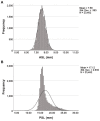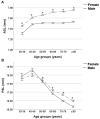Distribution of Ocular Anterior and Posterior Segment Lengths Among a Cataract Surgical Population in Shanghai
- PMID: 34631728
- PMCID: PMC8494767
- DOI: 10.3389/fmed.2021.688805
Distribution of Ocular Anterior and Posterior Segment Lengths Among a Cataract Surgical Population in Shanghai
Abstract
Purpose: To investigate the distributions of the ocular anterior and posterior segment lengths among a cataract surgical population in Shanghai. Design: Cross-sectional study. Methods: Ocular biometric parameters of 23,462 eyes of 23,462 cataract surgery candidates were reviewed. Axial length (AL), anterior chamber depth (ACD), and lens thickness (LT) were obtained using IOL Master. Anterior segment length (ASL = ACD + LT), posterior segment length (PSL = AL - ASL) and the ratio of ASL to PSL (ASL/PSL) were calculated. Results: The mean ASL was 7.58 ± 0.39 mm, the mean PSL was 17.12 ± 2.64 mm. As the age grew, the ASL increased, and PSL increased firstly then decreased. Male subjects tended to have significantly longer ASL and shorter PSL than female subjects. With the increasing AL, the ASL was firstly decreased to trough at 20-22 mm AL group, then increased gradually, while the PSL increased rapidly. The ASL correlated positively with AL in normal, moderate and highly myopic eyes, negatively in short eyes. The PSL correlated positively with AL across the entire study population. The ASL/PSL was not constant in the eyes with different AL but had a relatively steep downward trend with the increasing AL in the short eyes, then decreased smoothly in normal, moderate and highly myopic eyes. Conclusions: In Chinese cataractous eyes, longer ASL and shorter PSL were associated with elder age and male gender. The change of ASL over AL was not linear, and the ASL was smallest in the eyes with AL of 20-22 mm. The elongation of the eyeball was mainly due to the extension of the posterior segment.
Keywords: IOL Master 700; anterior segment length; axial length; cataract patients; posterior segment length.
Copyright © 2021 Qi, He, Meng, Wei, Qian, Lu and Zhu.
Conflict of interest statement
The authors declare that the research was conducted in the absence of any commercial or financial relationships that could be construed as a potential conflict of interest.
Figures




References
LinkOut - more resources
Full Text Sources
Research Materials

